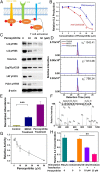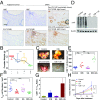Myeloid-derived suppressor cells inhibit T cell activation through nitrating LCK in mouse cancers
- PMID: 30232256
- PMCID: PMC6176562
- DOI: 10.1073/pnas.1800695115
Myeloid-derived suppressor cells inhibit T cell activation through nitrating LCK in mouse cancers
Abstract
Potent immunosuppressive mechanisms within the tumor microenvironment contribute to the resistance of aggressive human cancers to immune checkpoint blockade (ICB) therapy. One of the main mechanisms for myeloid-derived suppressor cells (MDSCs) to induce T cell tolerance is through secretion of reactive nitrogen species (RNS), which nitrates tyrosine residues in proteins involved in T cell function. However, so far very few nitrated proteins have been identified. Here, using a transgenic mouse model of prostate cancer and a syngeneic cell line model of lung cancer, we applied a nitroproteomic approach based on chemical derivation of 3-nitrotyrosine and identified that lymphocyte-specific protein tyrosine kinase (LCK), an initiating tyrosine kinase in the T cell receptor signaling cascade, is nitrated at Tyr394 by MDSCs. LCK nitration inhibits T cell activation, leading to reduced interleukin 2 (IL2) production and proliferation. In human T cells with defective endogenous LCK, wild type, but not nitrated LCK, rescues IL2 production. In the mouse model of castration-resistant prostate cancer (CRPC) by prostate-specific deletion of Pten, p53, and Smad4, CRPC is resistant to an ICB therapy composed of antiprogrammed cell death 1 (PD1) and anticytotoxic-T lymphocyte-associated protein 4 (CTLA4) antibodies. However, we showed that ICB elicits strong anti-CRPC efficacy when combined with an RNS neutralizing agent. Together, these data identify a previously unknown mechanism of T cell inactivation by MDSC-induced protein nitration and illuminate a clinical path hypothesis for combining ICB with RNS-reducing agents in the treatment of CRPC.
Keywords: LCK; immune checkpoint blockade; myeloid-derived suppressor cells; prostate cancer; protein nitration.
Conflict of interest statement
The authors declare no conflict of interest.
Figures




Similar articles
-
Effective combinatorial immunotherapy for castration-resistant prostate cancer.Nature. 2017 Mar 30;543(7647):728-732. doi: 10.1038/nature21676. Epub 2017 Mar 20. Nature. 2017. PMID: 28321130 Free PMC article.
-
Differential Targeting of Gr-MDSCs, T Cells and Prostate Cancer Cells by Dactolisib and Dasatinib.Int J Mol Sci. 2020 Mar 27;21(7):2337. doi: 10.3390/ijms21072337. Int J Mol Sci. 2020. PMID: 32230980 Free PMC article.
-
The kinase Itk and the adaptor TSAd change the specificity of the kinase Lck in T cells by promoting the phosphorylation of Tyr192.Sci Signal. 2014 Dec 9;7(355):ra118. doi: 10.1126/scisignal.2005384. Sci Signal. 2014. PMID: 25492967
-
T cell receptor signalling networks: branched, diversified and bounded.Nat Rev Immunol. 2013 Apr;13(4):257-69. doi: 10.1038/nri3403. Nat Rev Immunol. 2013. PMID: 23524462 Review.
-
The Emerging Role of CD244 Signaling in Immune Cells of the Tumor Microenvironment.Front Immunol. 2018 Nov 28;9:2809. doi: 10.3389/fimmu.2018.02809. eCollection 2018. Front Immunol. 2018. PMID: 30546369 Free PMC article. Review.
Cited by
-
Enhancing immune checkpoint blockade therapy of genitourinary malignancies by co-targeting PMN-MDSCs.Biochim Biophys Acta Rev Cancer. 2022 May;1877(3):188702. doi: 10.1016/j.bbcan.2022.188702. Epub 2022 Feb 25. Biochim Biophys Acta Rev Cancer. 2022. PMID: 35227829 Free PMC article.
-
Targeting and exploitation of tumor-associated neutrophils to enhance immunotherapy and drug delivery for cancer treatment.Cancer Biol Med. 2020 Feb 15;17(1):32-43. doi: 10.20892/j.issn.2095-3941.2019.0372. Cancer Biol Med. 2020. PMID: 32296575 Free PMC article. Review.
-
A comprehensive RNA editome reveals that edited Azin1 partners with DDX1 to enable hematopoietic stem cell differentiation.Blood. 2021 Nov 18;138(20):1939-1952. doi: 10.1182/blood.2021011314. Blood. 2021. PMID: 34388251 Free PMC article.
-
Current Advances in Basic and Translational Research of Cholangiocarcinoma.Cancers (Basel). 2021 Jul 1;13(13):3307. doi: 10.3390/cancers13133307. Cancers (Basel). 2021. PMID: 34282753 Free PMC article. Review.
-
The tumor ecosystem in head and neck squamous cell carcinoma and advances in ecotherapy.Mol Cancer. 2023 Apr 6;22(1):68. doi: 10.1186/s12943-023-01769-z. Mol Cancer. 2023. PMID: 37024932 Free PMC article. Review.
References
Publication types
MeSH terms
Substances
Grants and funding
LinkOut - more resources
Full Text Sources
Other Literature Sources
Research Materials
Miscellaneous

